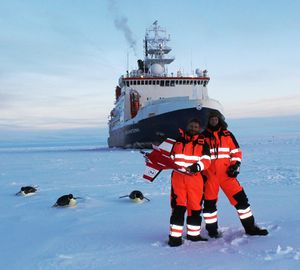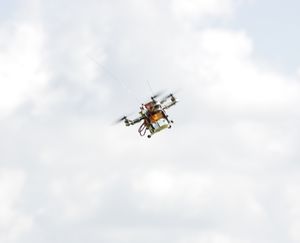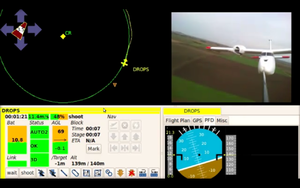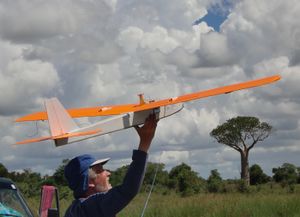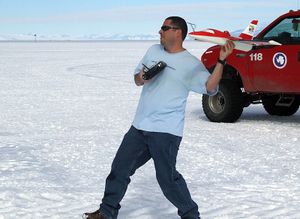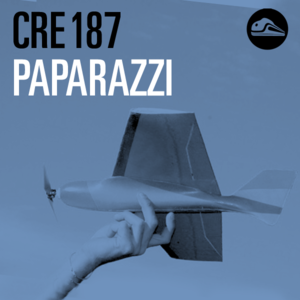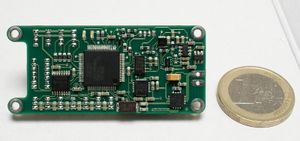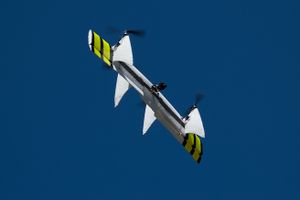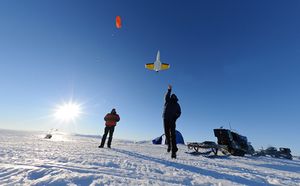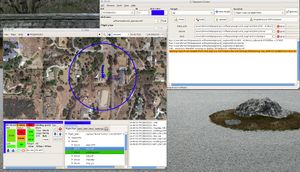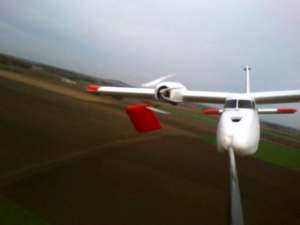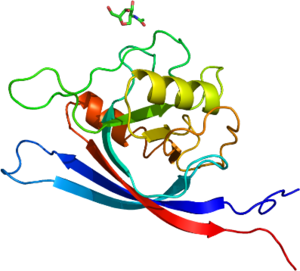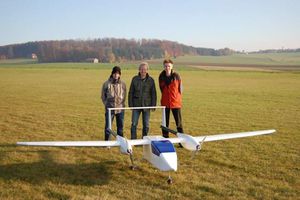|
|
 Blog
|
 Mailinglist
|
 Chat
|
 Download
|
 GitHub
|
 YouTube
|
|
|
The Paparazzi Project
|
| Paparazzi is a free and open-source hardware and software project intended to create an exceptionally powerful and versatile autopilot system for fixedwing aircrafts as well as multicopters by allowing and encouraging input from the community. The project includes not only the airborne hardware and software, from voltage regulators and GPS receivers to Kalman filtering code, but also a powerful and ever-expanding array of ground hardware and software including modems, antennas, and a highly evolved user-friendly ground control software interface.
|
| All hardware and software is open-source and freely available to anyone under the GNU licencing agreement. Several vendors are currently producing and selling Paparazzi autopilots and popular accessories, making the system easy and affordable to all.
|
| The key feature of the paparazzi autopilot is its unique combination of inertial measurement and/or infrared thermopiles for attitude sensing, providing a robust and accurate attitude estimate that requires no ground calibration and can recover from any launch attitude.
|
The Paparazzi project at ENAC
|
| The Paparazzi UAS project is now being used and developed at ENAC University and the MAVlab of the TU-Delft.
|
|
|
Legal disclaimer
|
| The Paparazzi software and hardware are distributed without any guarantee, in particular they are not certified by any national or international authorities. Before flying, please refer to your country national aviation regulation for Unmanned Aerial Systems, or the one of the country you intend to overfly.
|
Latest stable release
|
v5.0.0_stable
|
| Download as tarball or checkout the v5.0 branch from git.
|
News
|
July 18th, 2013
|
|
The Paparazzi autopilot is currently used for operations with remotely piloted aircraft from the Finnish Meteorological Institute for scientific research on board the R.V. Polarstern in the Weddell Sea/Antarctica. You can follow the course and read weekly reports on the homepage of the Alfred Wegener Institut.
Instructions on how to build your own small meteorological unmanned observer (SUMO) can be found here in the Wiki.
|
June 17th, 2013
|
|
NEW RELEASE!
For the opening of the Paris Air Show at Le Bourget, the Paparazzi Development Team is pleased to announce the release of the Paparazzi v5.0 stable version, including the support of the Parrot AR.Drone2. See this page for more instructions.
See the changelog for an overview of new features and bugfixes.
See the Release Upgrades page for hints on configuration changes that may be required if you are moving to v5.0.0 from v4.2.0.
If you are already using paparazzi with Git, you can switch to this new branch with
git remote update && git checkout v5.0.
For new user, you can download a tarball or get the source code with
git clone https://github.com/paparazzi/paparazzi.git && git checkout -b v5.0 origin/v5.0.
|
January 22nd, 2013
|
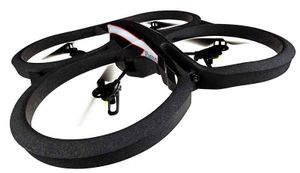 Paparazzi on the Parrot AR Drone 2 Parrot AR Drone flies autonomous
At the TU Delft university of technology student teams made the impossible; possible. Now you can turn your AR Drone v2 into an autonomous drone, controlled by Paparazzi autopilot software. It's simple, Insert GPS receiver into USB port, build and upload your flightplan via WiFi, and you are done! No hardware modification needed.
Detailed instructions to get your own drone fly with a Paparazzi autopilot brain can be found by following this link
...and remember, it is a Wiki, you are invited to improve the contents, as a matter of fact, we would love it!
|
December 12th, 2012
|
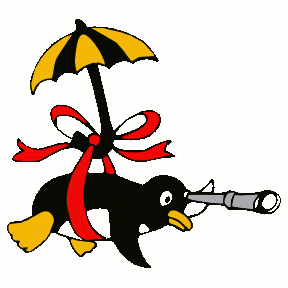 Paparazzi The Free Autopilot v4.2 released NEW RELEASE!
Just before the end of the world, discover Paparazzi v4.2.0 stable version.
Based on the last stable branch v4.0, this new release offer several improvements, especially the total energy control developed by TUDelft. See the changelog for an overview of new features and bugfixes.
If you are already using paparazzi with Git, you can switch to this new branch with
git remote update && git checkout v4.2.
For new user, it will be the default branch when getting the source code from Github. You can also download a tarball or Zip file of the v4.2.0_stable source code.
|
July 26th, 2012
|
|
Paparazzi was at the DefCon 20 conference in Las Vegas, USA from July 26th - 29th 2012 and presented the project.
|
July 26th, 2012
|
 Paparazzi The Free Autopilot NEW RELEASE!
The Paparazzi Development Team is pleased to announce the release of the Paparazzi v4.0 stable version.
After several months of testing and debugging, the release preparation branch v3.9 has been released as v4.0. See the changelog for an overview of new features and bugfixes.
If you are already using paparazzi with Git, you can switch to this new branch with
git remote update && git checkout v4.0.
For new user, it will be the default branch when getting the source code from Github. You can also download a tarball or Zip file of the v4.0_stable source code.
|
July 2-6th, 2012
|
|
Blender, the small but deserving quadrotor of ENAC Paparazzi Team took the 1st place in "Outdoor autonomy" and 3rd place in "Outdoor dynamics" during IMAV2012 competition in Braunschweig (Germany). Completing its missions with overflowing enthusiasm thanks to the new NavGo autopilot. NavGo is the latest in the long line of award winning Paparazzi hardware available. See the list of Paparazzi hardware here.
|
July 6th, 2012
|
|
ATMOS, a hybrid airplane-quadrotor developed at the MAVlab of TU-Delft, was awarded third place (out of 140) in the UAVForge Competition. There were more than 140 initial contestants and after several selection rounds with only 12 finalists, the paparazzi Lisa/M powered ATMOS was one of the few that could actually make it to the remote target site miles away in an RF unfriendly environment. No team fully completed the baseline objectives which is why no prices were issued. The vertical takeoff and landing, together with long range thanks to the wing and flexibility thanks to opensource paparazzi were key factors in this event [1].
But probably more important, the development of ATMOS has added a new code-base to paparazzi to enable the control of any hybrid multi-lifting device vehicle. ATMOS can take-off vertically as a quadrotor, transition to full forward flight as an airplane but also fly in any intermediate transition stage fully autonomously. So let your imagination go loose!
|
May 9th, 2012
|
|
In order to improve the development workflow and provide stable releases we have changed our git branching model.
The branch "master" is now our development branch.
- The "dev" branch was renamed to the release preparation branch "v3.9". Switch to this branch if you want stable code.
- "master" was reset to the previous "locm3" branch, where development will happen now with libopencm3 for the STM32 architecture.
Please see the RepositoryStructure page for more details.
As soon as we are ready to release v4.0 the will be tarballs available if you don't want to use Git.
|
May 8th, 2012
|
|
A lot of cool stuff is done with paparazzi driven UAV`s
To share the world what the paparazzi community is doing a youtube video play list generated. If you want your video in there send a youtube link to the mailing list.
|
April 9th, 2012
|
|
In March 2012, Paparazzi flew in southern Madagascar in the frame of a multi-university project to study and improve the ecosystem in one of the poorest regions of the world (Project). More than 4000 hectares of farm and grassland were photographed in visible and near infrared spectra. More than 8500 photos were taken. Surely one of the biggest missions for science ever flown with Paparazzi.
|
March 7th, 2012
|
|
In the Antarctic summer of 2011/2012 two teams flew Paparazzi-driven UAS on the southernmost continent. The University of Bergen flew at the Norwegian Troll station (video) and the University of Colorado near the US McMurdo station (blog, blog). They measured temperature, humidity, pressure, infrared radiation and wind with a Multiplex Funjet plane.
|
December 26th, 2011
|
|
We had a table at the 28C3 conference.
|
December 25th, 2011
|
|
Martin Müller gave a great interview about the history and the inner workings of Paparazzi on CRE Podcast.
|
October 5th, 2011
|
|
ENAC Team Umarim V1.0 autopilot is now released: LPC based, on-board IMU & barometer, narrow fuselage form factor (56x25mm) and lightweight (9gr) are its main features. Add your favorite GPS receiver and it will fit in your stupidly thin light UAV prototype. But it will also do the job for a big fat one. More info here...
|
September 18th, 2011
|
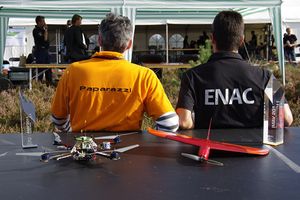 IMAV 2011 Outdoor Competition This year IMAV 2011 went really well for all of the participants, we have seen lots of successful flights. ENAC Paparazzi Team took the 2nd place in general "Outdoor Challenge" and Fire Storm demonstrated 105+ minutes of flight and took the "Best Outdoor Endurance Award". He was waiting this day for 2 years since the cancelation of IMAV09.
As an additional information, Fire Storm flew its endurance mission with the new Umarim V1.0 autopilot board which will be released soon.
|
August 31st, 2011
|
|
Paparazzi is used in the Quadshot: A blend between a quadrocopter and a flying wing. The Quadshot and Paparazzi are also featured in an episode of Hak5. You can also skip directly to the interview with Piotr talking about how Paparazzi is used in the Quadshot, and briefly explains the XML airframe file and the GCS.
|
February 15th, 2011
|
|
Paparazzi has flown on the southernmost continent: Antarctica. Scientists from the Finnish Meteorological Institute took three modified Funjets to the Finnish Aboa station and brought them back safely after more than 25 flights. They measured temperature, humidity, pressure, wind direction and speed in altitudes up to 1000m.
|
February 10th, 2011
|
|
Paparazzi now on OS X. Thanks to the tireless efforts of Eric and Bernard we can all run Paparazzi on OS X. Stay tuned Windows fans. Paparazzi on Windows is coming soon.
|
November 26th, 2010
|
|
There is a video available that shows how Paparazzis adaptive control loops keep a Twinstar in the air that drops 30% of its right wing with 50% of the aileron and then also switches the right engine off. Another video shows a Paparazzi quadcopter using adaptive control to stay level after dropping 50% of its total weight.
|
November 19th, 2010
|
|
WE MOVED TO GIT!
The paparazzi software repository now has a new happy life on github:
https://github.com/paparazzi/paparazzi
We believe the switch from Subversion to the fast git version control system will make development easier, faster and more fun. It also makes it easier for YOU to contribute. You can easily fork paparazzi on github, commit your bugfixes and new features and send us a pull request.
More info on how to get the paparazzi code from github can be found here.
We also want to encourage you to submit bugs or feature requests on the simple github issue tracker.
|
|
August, 2010
|
|
After many years of development, so many new autopilot boards and aircraft types have been added that a sourcecode reorganization was needed. This undertaking is started and will simplify the continuous evolution of the project.
To benefit from these important changes, it only requires you to update your airframe configuration document once. After you have updated, you should not notice the significant reorganization that is going on behind the scenes. This change will benefit your aircrafts flying successfully for the years to come. The required changes are described on Update Your Airframe Configuration.
At this point several developments are blocked because of this. Therefor we kindly request you to upgrade your airframe configuration documents as soon as possible and thank you in advance for doing so.
|
|
May 22th, 2010
|
|
Pascal Brisset, also known as Hecto, and the father of the Paparazzi project died in an accident while climbing in the Pyrénées mountains in the south of France.
He had dedicated the last seven years of his life to the success of the project. He was taking care by himself of a huge part of the project. To name only a few : development and maintenance of the entire ground segment, navigation and flight plan algorithms, code generation and build system, distribution packaging, server infrastructure...
To express your grief, you may want to leave a note on his wiki page
In respect for his commitment, the Paparazzi project must go on and volunteers wanting to take over tasks are hereby asked to do so.
|
|
February 19th, 2010
|
|
The Institute of space systems of University of Stuttgart is using the paparazzi system for large remote sensing aircrafts.
The missions include basic research and environmental monitoring. Payloads of up to 7kg are carried.
More information can be found on the Wiki page.
|
|
|
|
|
Browse the archives for a look back at the earlier days of Paparazzi.
|
|





